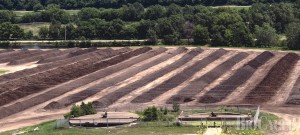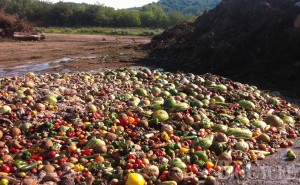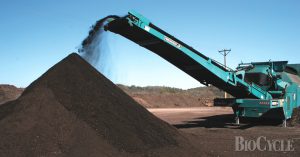In its 22nd year of composting, employees at the Cedar Rapids, Iowa facility share insights and experiences.
BioCycle June 2012, Vol. 53, No. 6, p. 28

The Cedar Rapids/Linn County Solid Waste Agency operates an open-air windrow composting facility at a downtown site along the Cedar River.
In 1994, the Cedar Rapids/Linn County Solid Waste Agency (Agency) was created. It took over responsibility for the composting facility from the City of Cedar Rapids at the same time. Today, the downtown site accepts 30,000 tons of material annually, primarily yard trimmings and a small amount of residential and commercial food waste. “When you’re in the middle of the city using open windrows, it’s a challenge to do much of anything but yard waste,” says Jerry Osten, Operations Manager, who has worked at the Cedar Rapids site for 21 years. “We’ve tried composting different industrial materials — sugar carbon, starch, seed corn, paper sludge, beans — but couldn’t keep the odor under control. We had to just say no.”
The majority of yard trimmings come from Cedar Rapids, although material is also received from other communities in Linn County. The Agency also accepts yard trimmings from residents at its landfill and recycling facility 20 miles away, which are then hauled to the downtown site for composting. The Agency charges a tipping fee of $18/ton for compostable material and $38/ton for landfill disposal.

The Cedar Rapids/Linn County Solid Waste Agency began receiving loads of food waste (above) from area Walmart stores in 2011.
Art And Science
All aspects of the composting operation are outdoors. Equipment includes a Morbark 7600 grinder, a Scarab turner and a Powerscreen trommel. Until mid-1994, the finished compost was used by city departments for operations and sold in bulk to local citizens for a nominal charge. Then the Agency started bagging the compost and selling it at retail outlets as Big Blue Topsoil. Eventually, the line was expanded to include a potting soil (blended with sand and perlite) as well as humus and compost. Automated bagging equipment was purchased in 1997. In 2002, over 300,000 bags of products were sold at Midwest supermarkets and area garden centers.“In the early 2000s, we sold millions of bags of Big Blue products — but not enough to stay in the business,” recalls Osten. “It was too cost-prohibitive to maintain the bagging operation.” In 2006, the Agency sold its bagging equipment to Garick Corporation. Today, compost is given away to Linn County residents and sold to businesses for $8/cubic yard. “I think there are a lot of untapped markets out there, especially in agriculture,” says Jason Fagle, the newest staff member at the composting site. “I’d like to see a lot more farmers using our compost.”
Facility employees are hands-on, and have found the art in composting is just as important as the science. They check and record windrow temperatures and moisture levels, turn the piles at prescribed times, and combine carbon to nitrogen at a 30:1 ratio. But, they are just as likely to stick their finger in the wind to check its direction, toss two buckets of leaves and one bucket of grass together for the right recipe and sniff the air to determine odor levels.
“Outside temperatures don’t matter as much as you’d think,” says Nutz. “The temperature in the middle of the pile is pretty consistent all year ’round. But if the temperature does get too low, we throw on some more grass!”
Mark Ingalls, whose main job is running the Morbark grinder, says injuries are far fewer now than in the past due, in part, to equipment upgrades. “The equipment is bigger — and better — and can handle pretty much anything that makes its way into the facility. I’ve had everything go through the grinder at one time or another — skunks, chainsaws, cell phones and a microwave once!”
This report is based on article that Marie DeVries, a planner at the Cedar Rapids/Linn County (IA) Solid Waste Agency, wrote for the Agency’s newsletter.











